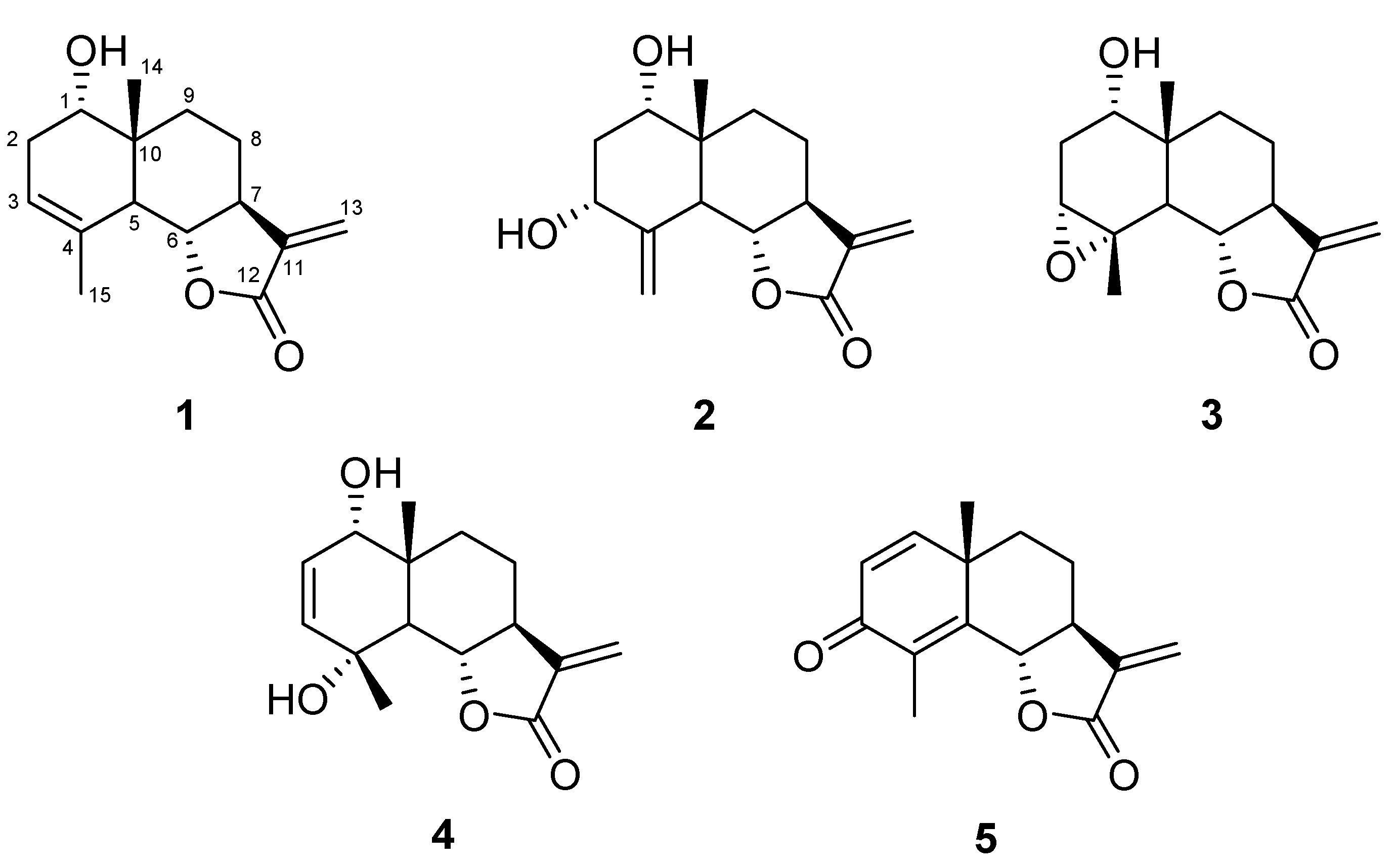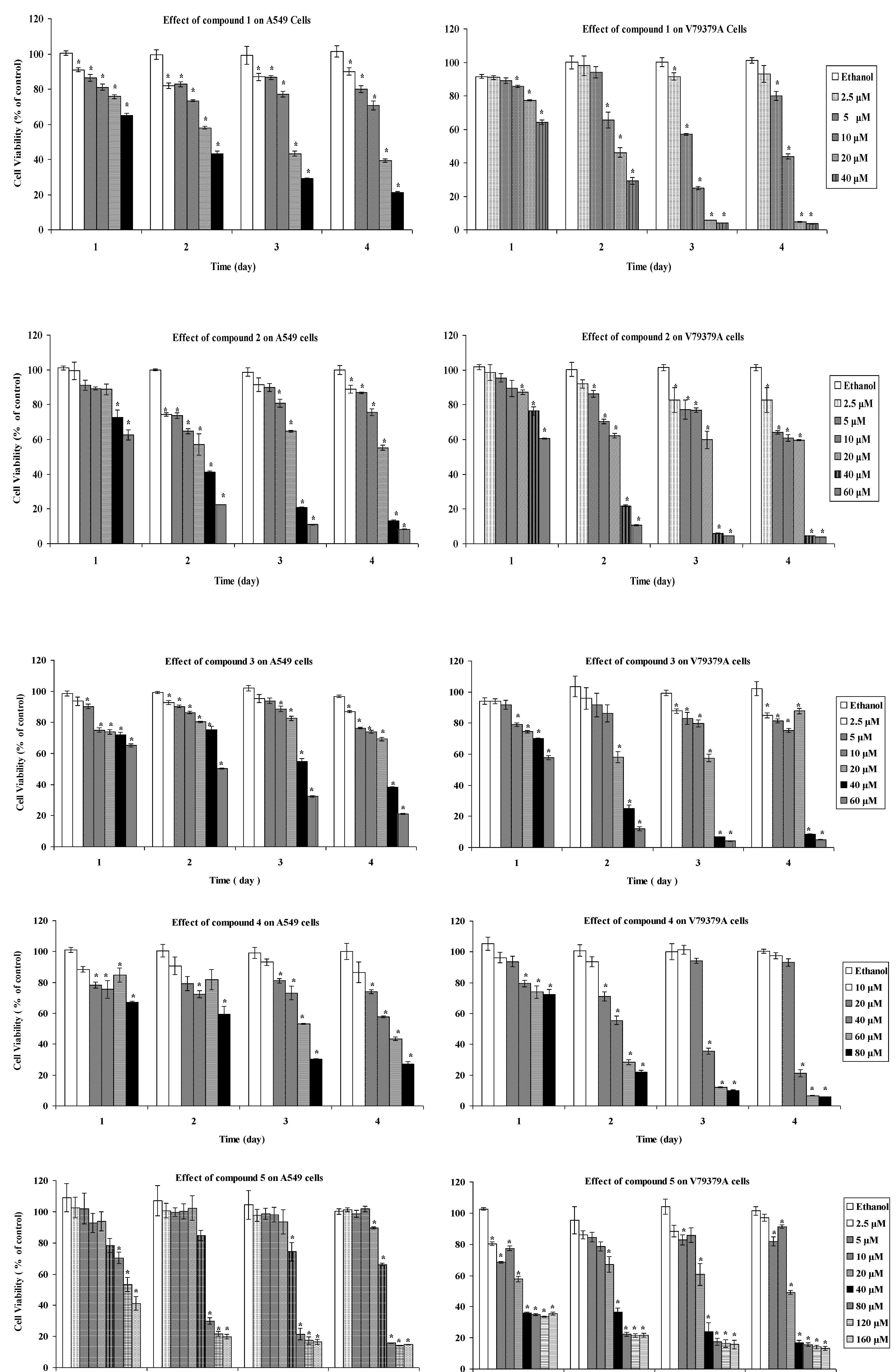Cytotoxic Effect of Eudesmanolides Isolated from Flowers of Tanacetum vulgare ssp. siculum
Abstract
:1. Introduction
2. Results and Discussion


| Compounds | A549 | V79379A |
|---|---|---|
| 1 | 15.3 ± 0.1 | 5.0 ± 0.8 |
| 2 | 26.4 ± 3.3 | 23.5 ± 2.2 |
| 3 | 34.4 ± 2.4 | 23.1 ± 1.6 |
| 4 | 59.4 ± 3.9 | 33.4 ± 0.6 |
| 5 | 56.6 ± 1.6 | 26.7 ± 0.9 |
| cisplatin | 7.7 ± 2.1 | 32.3 ± 2.5 |
3. Experimental
3.1. Plant Material
3.2. Extraction and Isolation
3.3. Cell Cultures
3.4. Cytotoxicity Assay
4. Conclusions
Acknowledgments
References
- Konopa, J.; Jereczek, E.; Matuszkiewicz, A.; Nazarewicz, T. Screening of antitumor substances from plants. Arch. Immunol. Ther. Exp. 1967, 15, 129–132. [Google Scholar] [Green Version]
- Williams, C.A.; Harborne, J.B.; Geiger, H.; Hoult, J.R. The flavonoids of Tanacetum parthenium and T. vulgare and their anti-inflammatory properties. Phytochemistry 1999, 51, 417–423. [Google Scholar] [Green Version]
- Mantle, D.; Eddeb, F.; Pickering, A.T. Comparison of relative antioxidant activities of British medicinal plant species in vitro. J. Ethnopharmacol. 2000, 72, 47–51. [Google Scholar] [CrossRef]
- Kubo, A.; Kubo, I. Antimicrobial agents from Tanacetum balsamita. J. Nat. Prod. 1995, 58, 1565–1569. [Google Scholar] [CrossRef]
- Evans, W.C. Trease and Evans’ Pharmacognosy, 14th ed; W.B. Saunders: London, UK, 1996; p. 288. [Google Scholar]
- Mordujovich-Buschiazzo, P.; Balsa, E.M.; Buschiazzo, H.O.; Mandrile, E.; Rosella, M.; Schinella, G.; Fioravanti, D. Anti-inflammatory activity of Tanacetum vulgare. Fitoterapia 1996, 67, 319–322. [Google Scholar]
- Juan-Badaturuge, M.; Habtemariam, S.; Jackson, C.; Thomas, M.J.K. Antioxidant principles of Tanacetum vulgare L. aerial parts. Nat. Prod. Commun. 2009, 4, 1561–1564. [Google Scholar]
- Kurkina, A.V.; Khusainova, A.I.; Daeva, E.D.; Kadentsev, V.I. Flavonoids from Tanacetum vulgare flowers. Chem. Nat. Compd. 2011, 47, 284–285. [Google Scholar] [CrossRef]
- lvarez, A.L.; Habtemariam, S.; Juan-Badaturuge, M.; Jackson, C.; Parra, F. In vitro anti HSV-1 and HSV-2 activity of Tanacetum vulgare extracts and isolated compounds: An approach to their mechanism of action. Phytother. Res. 2011, 25, 263–301. [Google Scholar]
- Marles, R.J.; Kaminski, J.; Arnason, J.T.; Pazos-Sanou, L.; Heptinstall, S.; Fischer, N.H.; Crompton, C.W.; Kindack, D.G.; Awang, D.V.C. A bioassay for inhibition of serotonin release from bovine platelets. J. Nat. Prod. 1992, 55, 1044–1056. [Google Scholar] [CrossRef]
- Wagner, S.; Hofmann, A.; Siedle, B.; Terfloth, L.; Merfort, I.; Gasteiger, J. Development of a structural model for NF-κB inhibition of sesquiterpene lactones using self-organizing neural networks. J. Med. Chem. 2006, 49, 2241–2252. [Google Scholar]
- Pikarsky, E.; Porat, R.M.; Stein, I.; Abramovitch, R.; Amit, S.; Kasem, S.; Gutkovich-Pyest, E.; Urieli-Shoval, S.; Galun, E.; Ben-Neriah, Y. NF-κB functions as a tumour promoter in inflammation-associated cancer. Nature 2004, 431, 461–466. [Google Scholar]
- Rohloff, J.; Mordal, R.; Dragland, S. Chemotypical variation of Tansy (Tanacetum vulgare L.) from 40 different locations in Norway. J. Agric. Food Chem. 2004, 52, 1742–1748. [Google Scholar]
- Mockute, D.; Judzentiene, A. Composition of the essential oils of Tanacetum vulgare L. growing wild in Vilnius District (Lithuania). J. Essent. Oil Res. 2004, 16, 550–553. [Google Scholar] [CrossRef]
- Todorova, M.; Ognyanov, I. Sesquiterpene lactones and chemotypes of bulgarian Tanacetum vulgare L. Dokl. Bulg. Akad. Nauk. 1999, 52, 41–44. [Google Scholar]
- Appendino, G.; Valle, M.G.; Nano, G.M. On a new chemotype of Tanacetum vulgare. Fitoterapia 1982, 53, 115–118. [Google Scholar]
- Appendino, G.; Gariboldi, P.; Nano, G.M. Tancetols A and B, non-volatile sesquiterpene alcohols, from Tanacetum vulgar. Phytochemistry 1983, 22, 509–512. [Google Scholar]
- Formisano, C.; Senatore, F.; Bruno, M.; Rosselli, S.; Bellone, G.; Spadaro, V. Essential oil composition of Tanacetum vulgare subsp. siculum (Guss.) Raimondo et Spadaro (Asteraceae) from Sicily. Nat. Prod. Commun. 2009, 4, 567–570. [Google Scholar]
- Matsueda, S.; Geissman, T.A. Sesquiterpene lactones of Artemisia species. IV. Douglanin from Artemisia douglasiana. Tetrahedron Lett. 1967, 23, 2159–2162. [Google Scholar] [CrossRef]
- Gören, N. Sesquiterpene lactones from Tanacetum praeteritum. Phytochemistry 1995, 38, 1261–1264. [Google Scholar]
- Gören, N.; Tahtasakal, E. Sesquiterpenoids from Tanacetum argenteum subsp. canum var.canum. Phytochemistry 1997, 45, 107–109. [Google Scholar]
- Lee, K.H.; Geissman, T.A. Sesquiterpene lactones of Artemisia constituents of Artemisia ludoviciana subsp. mexicana. Phytochemistry 1970, 9, 403–408. [Google Scholar]
- Barla, A.; Topçu, G.; Öksuz, S.; Tümen, G.; Kingston, D.G.I. Identification of cytotoxic sesquiterpenes from Laurus nobilis L. Food Chem. 2007, 104, 1478–1484. [Google Scholar]
- Rossi, C.; Ambrogi, V.; Grandolini, G.; Scarcia, V. Synthesis and in vitro cytotoxic activity of semisynthetic derivatives in the santonin series. J. Pharm. Sci. 1986, 75, 784–786. [Google Scholar] [CrossRef]
- Arantes, F.F.P.; Barbosa, L.C.A.; Alvarenga, E.S.; Demuner, A.J.; Bezerra, D.P.; Ferreira, J.R.O.; Costa-Lotufo, L.V.; Pessoa, C.; Moraes, M.O. Synthesis and cytotoxic activity of α-santonin derivatives. Eur. J. Med. Chem. 2009, 44, 3739–3745. [Google Scholar]
- Lesiak, K.; Koprowska, K.; Zalesna, I.; Nejc, D.; Duechler, M.; Czyz, M. Parthenolide, a sesquiterpene lactone from the medical herb feverfew, shows anticancer activity against human melanoma cells in vitro. Melanoma Res. 2010, 20, 21–34. [Google Scholar] [CrossRef]
- Pajak, B.; Gajkowska, B.; Orzechowski, A. Molecular basis of parthenolide-dependent proapoptotic activity in cancer cells. Folia Histochem. Cytobiol. 2008, 46, 129–135. [Google Scholar]
- Goun, E.A.; Petrichenko, V.M.; Solodnikov, S.U.; Suhinina, T.V.; Kline, M.A.; Cunningham, G.; Nguyen, C.; Miles, H. Anticancer and antithrombin activity of Russian plants. J. Ethnopharmacol. 2002, 81, 337–342. [Google Scholar] [CrossRef]
- Gören, N.; Woerdenbag, H.J.; Bozok-Johansson, C. Cytotoxic and antibacterial activities of sesquiterpene lactones isolated from Tanacetum praeteritum subsp. praeteritum. Planta Med. 1996, 62, 419–422. [Google Scholar]
- Bruno, M.; Rosselli, S.; Maggio, A.; Raccuglia, R.A.; Bastow, K.F.; Wu, C.C.; Lee, K.-H. Cytotoxic activity of some natural and synthetic sesquiterpene lactones. Planta Med. 2005, 71, 1176–1178. [Google Scholar] [CrossRef]
- Rosselli, S.; Maggio, A.; Eiroa, C.; Formisano, C.; Bruno, M.; Irace, C.; Maffettone, C.; Mascolo, N. Cytotoxic activity of diterpenoids isolated from the aerial parts of Elaeoselinum asclepium subsp. meoides. Planta Med. 2008, 74, 1285–1287. [Google Scholar] [CrossRef]
- Rosselli, S.; Maggio, A.M.; Faraone, N.; Spadaro, V.; Morris-Natschke, S.L.; Bastow, K.F.; Lee, K.-H.; Bruno, M. The cytotoxic properties of natural coumarins ısolated from roots of Ferulago campestris (Apiaceae) and of synthetic ester derivatives of aegelinol. Nat. Prod. Commun. 2009, 4, 1701–1706. [Google Scholar]
- Koparal, A.T.; Ayaz Tuylu, B.; Turk, H. In vitro cytotoxic activities of (+)-usnic acid and (−)-usnic acid on V79, A549, and human lymphocyte cells and their non-genotoxicity on human lymphocytes. Nat. Prod. Res. 2006, 20, 1300–1307. [Google Scholar] [CrossRef]
- Hu, J.; Zhu, Q.; Jia, Z. Assigment of the 1H and 13C-NMR spectra of ludovicin B by two-dimensional NMR techniques. Bull. Soc. Chim. Belg. 1997, 106, 141–146. [Google Scholar]
- Mosmann, T. Rapid colorimetric assay for cellular growth and survival: Application to proliferation and cytotoxicity assays. J. Immunol. Methods 1983, 65, 55–63. [Google Scholar]
- Sample Availability: Samples of the compounds are available from the authors.
© 2012 by the authors; licensee MDPI, Basel, Switzerland. This article is an open-access article distributed under the terms and conditions of the Creative Commons Attribution license (http://creativecommons.org/licenses/by/3.0/).
Share and Cite
Rosselli, S.; Bruno, M.; Raimondo, F.M.; Spadaro, V.; Varol, M.; Koparal, A.T.; Maggio, A. Cytotoxic Effect of Eudesmanolides Isolated from Flowers of Tanacetum vulgare ssp. siculum. Molecules 2012, 17, 8186-8195. https://doi.org/10.3390/molecules17078186
Rosselli S, Bruno M, Raimondo FM, Spadaro V, Varol M, Koparal AT, Maggio A. Cytotoxic Effect of Eudesmanolides Isolated from Flowers of Tanacetum vulgare ssp. siculum. Molecules. 2012; 17(7):8186-8195. https://doi.org/10.3390/molecules17078186
Chicago/Turabian StyleRosselli, Sergio, Maurizio Bruno, Francesco Maria Raimondo, Vivienne Spadaro, Mehmet Varol, Ayşe Tansu Koparal, and Antonella Maggio. 2012. "Cytotoxic Effect of Eudesmanolides Isolated from Flowers of Tanacetum vulgare ssp. siculum" Molecules 17, no. 7: 8186-8195. https://doi.org/10.3390/molecules17078186
APA StyleRosselli, S., Bruno, M., Raimondo, F. M., Spadaro, V., Varol, M., Koparal, A. T., & Maggio, A. (2012). Cytotoxic Effect of Eudesmanolides Isolated from Flowers of Tanacetum vulgare ssp. siculum. Molecules, 17(7), 8186-8195. https://doi.org/10.3390/molecules17078186




